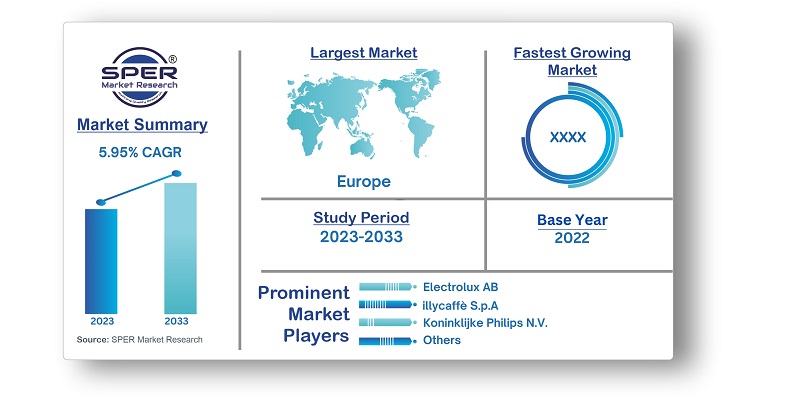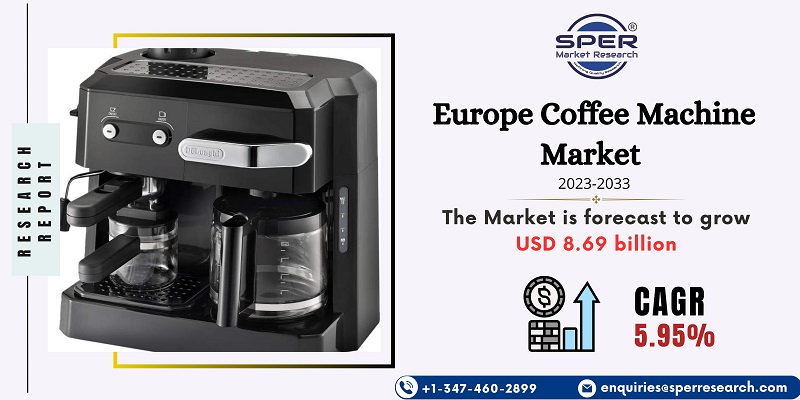
Europe Coffee Machine Market Growth, Trends, Size, Revenue, Share, Demand and Future Outlook
Europe Coffee Machine Market Size- By Type, By Category, By End User- Regional Outlook, Competitive Strategies and Segment Forecast to 2033
| Published: Dec-2023 | Report ID: FMCG23148 | Pages: 1 - 155 | Formats*: |
| Category : Consumer & Retail | |||
- Nestle Nespresso S.A. introduced new touchless and low touch functionalities to its Nespresso momento line, ensuring safer coffee experiences. Touchless technology has increased safety and sanitary precautions while allowing employees to maintain social interactions. It enables a remote control solution, allowing customers to control the machine to their mobile phones.
 Market Opportunities and Challenges
Market Opportunities and Challenges
| Report Metric | Details |
| Market size available for years | 2019-2033 |
| Base year considered | 2022 |
| Forecast period | 2023-2033 |
| Segments covered | By Type, By Category, By End User |
| Regions covered | Central Region, Southern Region, Northern Region |
| Companies Covered | Electrolux AB, illycaffè S.p.A., Koninklijke Philips N.V., Krups GmBH (Groupe SEB), Morphy Richards, Nestlé S.A, Panasonic Corporation, Robert Bosch GmbH, Others. |
- Home Consumers
- Commercial Establishments:
- Cafés, coffee shops
- Office Spaces
- Retail Consumers
- Coffee Roasters and Suppliers
| By Type: |
|
| By Category: |
|
| By End-User: |
|
- Europe Coffee Machine Market Size (FY’2023-FY’2033)
- Overview of Europe Coffee Machine Market
- Segmentation of Europe Coffee Machine Market By Type (Filter Coffee Machines, Espresso Coffee Machines, Capsule and Pod Coffee Machines, Others)
- Segmentation of Europe Coffee Machine Market By Category (Manual, Automatic and Semi-Automatic)
- Segmentation of Europe Coffee Machine Market By End-User (Residential, Non- Residential)
- Statistical Snap of Europe Coffee Machine Market
- Expansion Analysis of Europe Coffee Machine Market
- Problems and Obstacles in Europe Coffee Machine Market
- Competitive Landscape in the Europe Coffee Machine Market
- Impact of COVID-19 and Demonetization on Europe Coffee Machine Market
- Details on Current Investment in Europe Coffee Machine Market
- Competitive Analysis of Europe Coffee Machine Market
- Prominent Players in the Europe Coffee Machine Market
- SWOT Analysis of Europe Coffee Machine Market
- Europe Coffee Machine Market Future Outlook and Projections (FY’2023-FY’2033)
- Recommendations from Analyst
1.1. Scope of the report1.2. Market segment analysis
2.1. Research data source
2.1.1. Secondary Data2.1.2. Primary Data2.1.3. SPER’s internal database2.1.4. Premium insight from KOL’s
2.2. Market size estimation
2.2.1. Top-down and Bottom-up approach
2.3. Data triangulation
4.1. Driver, Restraint, Opportunity and Challenges analysis
4.1.1. Drivers4.1.2. Restraints4.1.3. Opportunities4.1.4. Challenges
4.2. COVID-19 Impacts of the Europe Coffee Machine Market
5.1. SWOT Analysis
5.1.1. Strengths5.1.2. Weaknesses5.1.3. Opportunities5.1.4. Threats
5.2. PESTEL Analysis
5.2.1. Political Landscape5.2.2. Economic Landscape5.2.3. Social Landscape5.2.4. Technological Landscape5.2.5. Environmental Landscape5.2.6. Legal Landscape
5.3. PORTER’s Five Forces
5.3.1. Bargaining power of suppliers5.3.2. Bargaining power of buyers5.3.3. Threat of Substitute5.3.4. Threat of new entrant5.3.5. Competitive rivalry
5.4. Heat Map Analysis
6.1. Europe Coffee Machine Market Manufacturing Base Distribution, Sales Area, Product Type6.2. Mergers & Acquisitions, Partnerships, Product Launch, and Collaboration in Europe Coffee Machine Market
7.1. Europe Coffee Machine Market Value Share and Forecast, By Type, 2023-20337.2. Filter Coffee Machines7.3. Espresso Coffee Machines7.4. Capsule and Pod Coffee Machines7.5. Others
8.1. Europe Coffee Machine Market Value Share and Forecast, By Category, 2023-20338.2. Manual8.3. Automatic and Semi-Automatic
9.1. Europe Coffee Machine Market Value Share and Forecast, By End-User, 2023-20339.2. Residential9.3. Non- Residential
10.1. Europe Coffee Machine Market Size and Market Share
11.1. Europe Coffee Machine Market Size and Market Share By Type (2019-2026)11.2. Europe Coffee Machine Market Size and Market Share By Type (2027-2033)
12.1. Europe Coffee Machine Market Size and Market Share By Category (2019-2026)12.2. Europe Coffee Machine Market Size and Market Share By Category (2027-2033)
13.1. Europe Coffee Machine Market Size and Market Share By End-User (2019-2026)13.2. Europe Coffee Machine Market Size and Market Share By End-User (2027-2033)
14.1. Europe Coffee Machine Market Size and Market Share By Region (2019-2026)14.2. Europe Coffee Machine Market Size and Market Share By Region (2027-2033)14.3. Germany14.4. France14.5. U.K.14.6. Denmark14.7. Norway14.8. Sweden14.9. Rest of Europe
15.1. Electrolux AB
15.1.1. Company details15.1.2. Financial outlook15.1.3. Product summary15.1.4. Recent developments
15.2. illycaffè S.p.A.
15.2.1. Company details15.2.2. Financial outlook15.2.3. Product summary15.2.4. Recent developments
15.3. Koninklijke Philips N.V.
15.3.1. Company details15.3.2. Financial outlook15.3.3. Product summary15.3.4. Recent developments
15.4. Krups GmBH (Groupe SEB)
15.4.1. Company details15.4.2. Financial outlook15.4.3. Product summary15.4.4. Recent developments
15.5. Morphy Richards
15.5.1. Company details15.5.2. Financial outlook15.5.3. Product summary15.5.4. Recent developments
15.6. Nestlé S.A
15.6.1. Company details15.6.2. Financial outlook15.6.3. Product summary15.6.4. Recent developments
15.7. Panasonic Corporation
15.7.1. Company details15.7.2. Financial outlook15.7.3. Product summary15.7.4. Recent developments
15.8. Robert Bosch GmbH
15.8.1. Company details15.8.2. Financial outlook15.8.3. Product summary15.8.4. Recent developments
15.9. Others
SPER Market Research’s methodology uses great emphasis on primary research to ensure that the market intelligence insights are up to date, reliable and accurate. Primary interviews are done with players involved in each phase of a supply chain to analyze the market forecasting. The secondary research method is used to help you fully understand how the future markets and the spending patterns look likes.
The report is based on in-depth qualitative and quantitative analysis of the Product Market. The quantitative analysis involves the application of various projection and sampling techniques. The qualitative analysis involves primary interviews, surveys, and vendor briefings. The data gathered as a result of these processes are validated through experts opinion. Our research methodology entails an ideal mixture of primary and secondary initiatives.



Frequently Asked Questions About This Report
PLACE AN ORDER
Year End Discount
Sample Report
Pre-Purchase Inquiry
NEED CUSTOMIZATION?
Request CustomizationCALL OR EMAIL US
100% Secure Payment






Related Reports
Our Global Clients
Our data-driven insights have influenced the strategy of 200+ reputed companies across the globe.




















